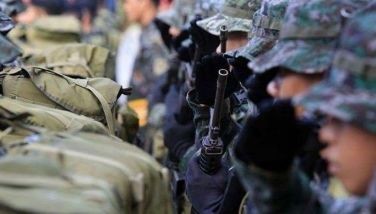Indonesian fires? Light haze affects Metro
MANILA, Philippines - A light haze is affecting Metro Manila, but the Philippine Atmospheric, Geophysical and Astronomical Services Administration (PAGASA) will not confirm that it is caused by Indonesian forest fires.
Robert Sawi, PAGASA assistant weather services chief, said it is unlikely that the haze in Manila came from Indonesia because winds blowing from the northeast are currently prevailing in the country.
The Department of Health is also looking into reports that two individuals have died due to the haze in General Santos City.
“It’s still being verified. It might not be related,” Health Secretary Janette Garin said.
President Aquino also stressed yesterday that the country is not inclined to support a call to hold Indonesia accountable for the haze that crossed borders but would rather like to help the Southeast Asian neighbor.
“Well, the haze affecting us… just happened recently. We’re actually asking our Department of Science and Technology to study the whole matter and deliver recommendations as to what actions we should take,” Aquino said at the annual presidential forum of the Foreign Correspondents Association of the Philippines.
“Having said that, instead of castigating an ASEAN (Association of Southeast Asian Nations) brother-country, perhaps in the ASEAN summit, we should really look for the wherewithal, the direction, the attitude –attitudinal change whereby we can help Indonesia avoid creating this problem,” the President added.
He said it would be the most “constructive” thing to do rather than concentrate “on apportioning blame.”
The labor coalition Nagkaisa also urged Aquino yesterday to immediately activate and order the Inter-Agency Committee on Environmental Health (IACEH) to draft programs that will address the problem’s impact on people’s health.
Gerard Seno, executive vice president of the Associated Labor Union (ALU) and a Nagkaisa member, said the government should be ready with a plan in case haze reaches Metro Manila and puts at risk the lives of 12 million people.
At the House, Quezon City Rep. Alfred Vargas said he would ask the Department of Health (DOH) for a comprehensive report on various health hazards, especially those affecting women and children, in the environment.
He lamented that the country was listed as having the highest female adult mortality rate in Southeast Asia at 144 deaths per 1,000 and the fourth highest in child and infant mortality at 30 deaths per 1,000 live births.
Seno said he would rather have the government prepare for an eventuality now than be sorry later on.
“The inter-agency committee on environmental health should respond quickly to the already affected residents in some parts of Visayas and Mindanao. We also wanted Philippine government to take the necessary action to prepare the vulnerable segment Metro Manila residents to cope with the possible long-term, toxic presence of haze,” Seno noted, as he cited Executive Order 489 that provides for the creation of IACEH, which will facilitate government response against environmental hazards.
Based on reports, the Indonesian Disaster Agency estimated that around 500,000 people have developed respiratory problems since the fires began in July. Millions of people are dealing with smoke levels roughly 10 times the level the World Health Organization considers hazardous.
Health Assistant Secretary Gerry Bayugo said they are investigating the reported deaths in General Santos because “not all deaths that occurred in the affected areas should be attributed to haze.”
“From time to time, there are people who die of illnesses or some other reasons. What we must do is to verify the cause of death,” Bayugo added.
The DOH earlier issued a health advisory on how those living in areas reached by haze should cope.
On Sunday, Malacañang also said that concerned government agencies were monitoring the haze from Indonesia, including the departments on Environment and Natural Resources, Science and Technology, Health, and Transportation and Communications (DOTC). The local disaster risk reduction management councils are also helping monitor the situation.
Presidential Communications Operations Office Secretary Herminio Coloma Jr. said they were looking into the long-term effects of the haze as he cited a PAGASA report that the thick haze observed in some areas in Mindanao was brought by equatorial winds enhanced by Typhoon Lando, which hit the country last week.
He added that the DENR was looking into the air situation in Davao, Cotabato, Zamboanga and other monitoring stations in Mindanao.
PAGASA’s Sawi said the haze in Manila could be could be due to the pollution brought by motor vehicles.
“This (yesterday) morning, data showed that the visibility is between seven and 10 kilometers,” he said.
A visibility of less than five km is considered heavy, less than eight km is moderate, and less than 10 km is considered light haze.
At 8 a.m. yesterday, light haze was observed at the PAGASA station at the Science Garden in Quezon City, while moderate haze was spotted over Zamboanga peninsula.With Sheila Crisostomo, Aurea Calica, Delon Porcalla, Mayen Jaymalin, Paolo Romero, Artemio Dumlao
- Latest
- Trending






























